In records, Fascadale is sometimes listed as a separate settlement and sometimes subsumed into Achateny. According to Kirby (2015) [1] Fascadale had tenants recorded back to 1541 but the data indicates poorer agricultural land, lower rents and fewer tenants than Achateny.
Fascadale’s name appears to reflect its maritime relevance, meaning ‘valley of the ship’ or ‘shelter’
Fascadale ice house
Today the ice house stands peacefully overlooking beautiful Fascadale bay. But it was once the centre of a busy industrial landscape where salmon were landed and packed in ice for transportation to London markets


Its history tells the story of the development and decline of commercial salmon fishing and the economic and environmental changes that took place in the 19th and 20th centuries.
The use of ice for packing salmon for preservation without the need for curing was a significant development in the growth of commercial salmon fishing. Ice was first used in the transportation of salmon by the River Tay fisheries in 1786 [2] Initially this method was used only in the spring when ice was available. Ice houses allowed salmon to be packed with ice throughout the season and were built from the late 18th century in some locations. But in other areas, including Ardnamurchan, ice houses were not adopted until the mid nineteenth century after new legislation and improved transportation made commercial fishing more viable.
Fascadale ice house, along with some residential property was probably built in the 1860s by James Dalgleish the estate owner to develop commercial salmon fishing in Ardnamurchan. It appears on the 1872 OS map together with a yard/ works area and pond.
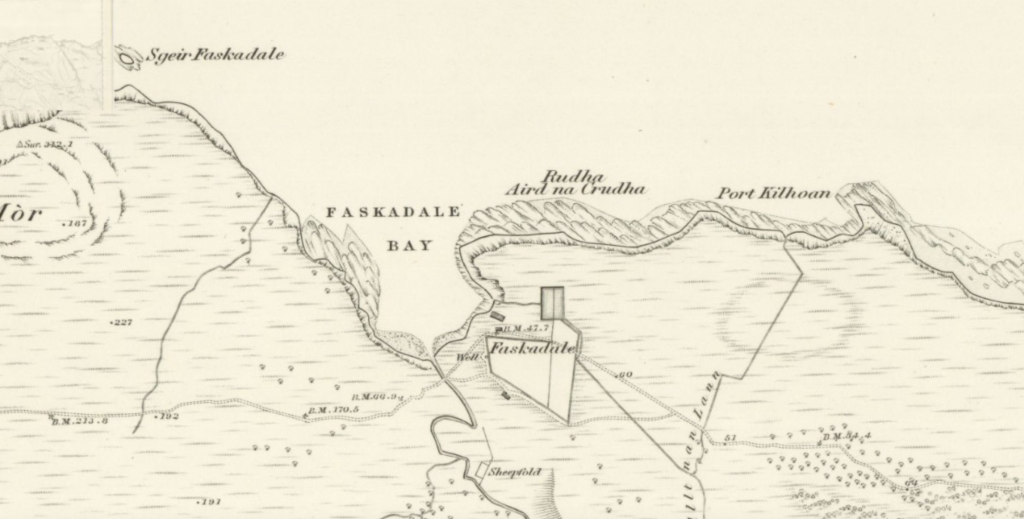
Ice was made by artificially creating ponds from naturally flowing streams and allowing it to freeze in the winter. It was then transported by pony and cart the short distance to the ice house and loaded from a top hatch into the ice house itself. The design of the ice house kept the ice frozen through the summer season. . A small shed just beyond the building towards the shore is believed to have housed the pony.

Ice making also changed over the time and by the mid twentieth century, ice making machines were being used, the first run by a generator as there was no mains electricity in Fascadale until the 1970s. Warmer winters have ruled out the possibility of making ice in the traditional way.
The ice house and pony shed are all that remain of the original buildings. There are now holiday cottages on the sites of the proprietor’s house and bothy.
The ice house is one of 10 sites selected as part of an Archaeology Scotland ‘Adopt a Monument’ scheme in Ardnamurchan 2021-2023 funded by Nature Scotland, Historic Environment Scotland and the European Regional Development Fund (ERDF).
At Fascadale, the work included community projects to clear out many years worth of sheep manure (to the benefit of local gardens), painting the packing shed which provided a home for the OB209, the Coble fishing boat which returned to its first home in Fascadale. Read more about that below.
Fishing for Salmon
We don’t know when salmon fishing first began in Fascadale and elsewhere. The remains of a fish trap at Achateny suggests this was a good spot for fishing and could possibly have been used for salmon before the fixed bag nets came into use.
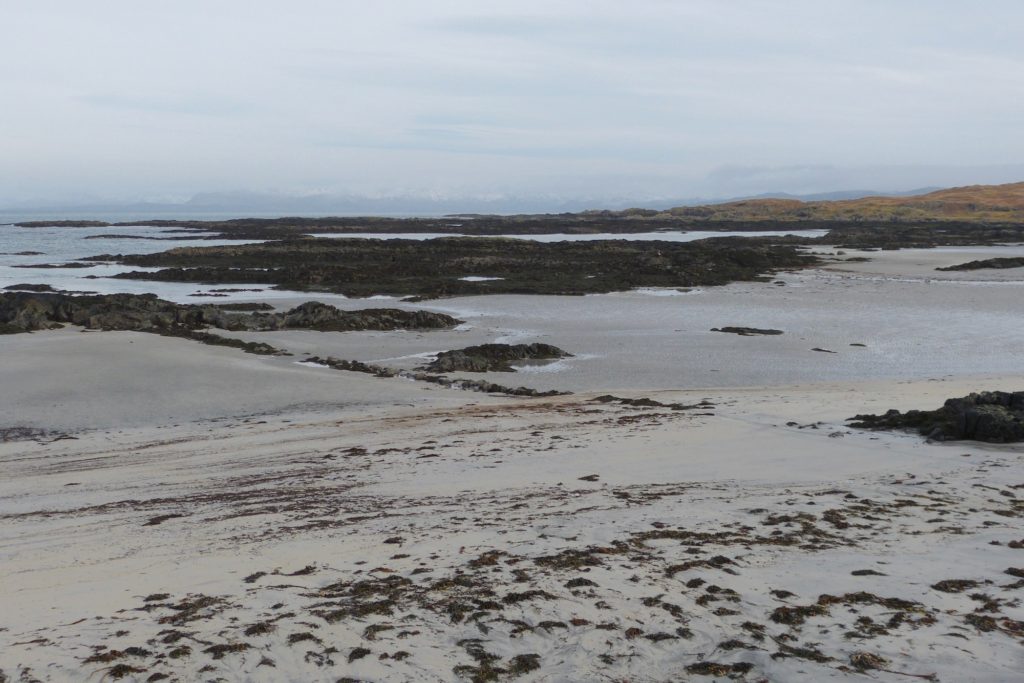
Although salmon fishing became important as a commercial activity in Scotland from medieval times, Ardnamurchan’s remote geography is likely to have meant most of the salmon caught here would have been consumed locally and probably sought out by the clan leaders and richer individuals as it carried an elite status. Salmon fishing rights were owned by Ardnamurchan landowners but we can imagine that locals enjoyed a surreptitiously caught fish or two.
Timeline – commercial salmon fishing in Ardnamurchan
2019
Bag nets for salmon fishing abolished
2016
Legislation introduced for pause in use of bag nets
1992
Ardnamurchan Estate take over Fascadale and fishings
1986
Mark James becomes proprietor at Fascadale
1968
Rhoddy Macleod takes over at Fascadale
1949
Robert Powrie buys the fishings from landowner Lord Trent.
@1891
Powrie family lease Ardnamurchan fishing rights and property in Fascadale and Kilchoan
1860s
Ice house and houses for tacksmen built. Mitchell family run the fishings.
1855
James Gemmell, possibly the first salmon tacksman appears on valuation rolls
Achateny /Fascadale cottars evicted @ 1853.
1841
Documentary evidence of salmon fishing at Achateny/Fascadale
Times of eviction / emigration
Landowners believed or advised that fishing would provide alternative employment for tenants.
Time of the clans
Salmon gains an elite status. Some preservation by ‘kitting’ (curing in vinegar) and salting. Scottish kings, concerned about loss of revenue from dwindling stocks start to introduce restrictive legislation from 1200s. Salmon fishing rights were owned by the crown and established as a distinct property right in Scots Law [3] Ardnamurchan was given a grant from the crown and the fishing rights rested with the landowner.
Early medieval
Vikings fished with nets for salmon. Probably started commercial fishing by selling dried white fish on the Scottish east coast.
Prehistory
Subsistence fishing limited by the technology available. Fish remained part of the diet in coastal populations from Mesolithic times but might have dipped with the introduction of farming. [4 ]
Although there was a lucrative trade on the east coast of Scotland in the 18th and 19th centuries, there is no evidence of any commercial salmon fishing in the more remote Ardnamurchan until the mid 19th century. The Statistical Accounts of Scotland (1795 – 1845) [5] make no mention of salmon fishing or fishing stations in Ardnamurchan in contrast to the many references elsewhere in Scotland. Although it does mention fisherman coming from the east via Loch Shiel to fish in western waters.
Despite the desires of estate owners Alexander Murray and subsequently the Riddles, fishing did not provide a panacea to ‘improve’ the value of the estate and provide alternative employment for evicted tenants in the 1700s and early 1800s. Salmon fishing is seasonal, requires specific expertise and equipment, is beset with legal limitations and high rents were required by landowners for the salmon rights.
It’s not surprising that a series of families from outside Ardnamurchan with the required expertise and funds became salmon ‘tacksmen’ and arrived seasonally to fish salmon.
The first written evidence of the beginnings of a commercial salmon fishing enterprise is from the 1841 census when a group of salmon fishermen and a boat builder predominantly from outside the area are recorded as being in Achateny. In one household there was a group of seemingly unrelated males, perhaps living in a bothy type arrangement for the summer season. We don’t know if they were working for a ‘tacksman’, directly for the estate or on their own account
James Gemmell from Ayr was an early tenant of the fishings. He appears on the valuation rolls in 1855, paying a yearly rent of £320 for the Ardnamurchan fishings to the trustees of the estate, a large sum in those times. He was living in Shielfoot in 1851 but records tell us that his son, another James, was born in Fascadale in 1849. He came into dispute with the neighbouring Moidart landowner. A court case in 1855 cites Gemmell as a respondent to a complaint from the Moidart estate about encroachment of their traditional salmon fishing rights. Perhaps he employed the Dalsons, a fishing family from Banffshire recorded on the 1861 census as living in Achateny, one of whom was a fish curer
Commercial fishing accelerated in the 1860s when James Dalgleish was the landowner. The Salmon Fisheries (Scotland) Act of 1862 allowed the use of fixed nets which had been previously banned. Fascadale’s sheltered bay, access to salmon and largely unoccupied space following the 1853 evictions meant Dalgleish could develop it for salmon fishing and for lease to salmon ‘tacksmen’ to run the fisheries. He is likely to have instigated the building of the ice house, and new housing at Fascadale. Transportation of the ice cooled salmon to urban markets became easier first with the development of the steam driven puffer boats (1870s) and then the opening of railways at Oban (1880), Fort William (1894) and Mallaig ( 1901) providing a fast route to the profitable London markets.
The tacksmen were experienced in salmon fishing and came from outside the area. They generally only lived in Fascadale for the salmon fishing season when they employed local labour over the summer months.
The Mitchell family from Aberdeen were probably the first to run the newly developed salmon fishery in both Fascadale and Kilchoan (and to make use of the ice house) from the 1860s. Alexander and William Mitchell were born in Aberdeen, sons of a salmon fisherman. They occupied what appears to be 2 new houses in Fascadale from sometime in the 1860s until the 1880s. William spent more time in Fascadale than Alexander and five of his six children were born in Ardnamurchan. He moved to Mull to become a salmon fishing tacksman and was living on Shore Street in Tobermory in 1891. His elder son Alex was still salmon fishing in Mull in 1911.
Andrew Powrie with his wife Kate had taken over the Fascadale fisheries by 1891. The Powrie family came from Perth, and was called by historian Iain Robertson a salmon fishing ‘dynasty’ [2 ]Andrew was a younger brother of Archibald Powrie in whose name the umbrella company A Powrie & Co. was formed.

Other brothers and their families ran coastal salmon fishings in Gairloch, Laide, Skye and on the Kincardineshire and Aberdeenshire coasts.
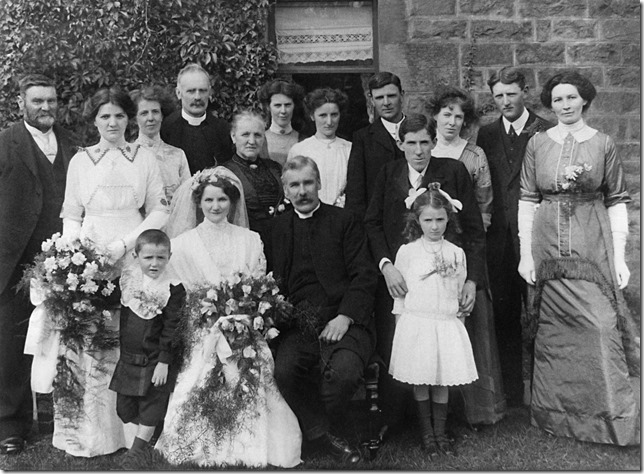
Robert Powrie took over at Fascadale after his father’s death in 1936 until his own untimely demise in a car accident in 1951, after which his widow Pauline ran the show.
It was not so unusual for women to run the fishings. Other Powrie widows also took charge at Gairloch and Gaimrie in the 1940s, 50s and 60s. Given the times, they often gained local reputations as being strict with corresponding nicknames e.g. ’dragon’ . Pauline at Fascadale admitted to family that she felt compelled to be non compromising because of her gender, fearing lack of respect if she showed a softer side.
Pauline was also affectionately nicknamed the ‘cuckoo’ as she arrived in Fascadale each Spring for the salmon season.
In the 60+ years that the Powries were at Fascadale, there were netting stations at Kilchoan, Ockle and Gortenfern in addition to Fascadale itself. The fish was gathered and packed at Fascadale. A fishing station on the island of Soay, off Skye was included in the Ardnamurchan fishery for a few years pre and post the Second World War.
In 1949, the estate owner, Lord Trent offered the fishings to Robert Powrie who bought them outright for £3,500, a bargain at the time.
Eye witnesses over the time of the Powrie ownership recall massive catches and the Cobles being full of fish as they returned back to the packing station.
This link to the National Library’s moving image collection is to an amateur film recorded in 1950 about Ardnamurchan. It includes a short section about Fascadale (2.21). The fishing action shown is at Kilchoan but the net hanging is probably back at Fascadale.
Rhoddy and Bobby Macleod bought the Fascadale and Kilchoan fishing stations from Pauline Powrie in 1968. Fish stocks were starting to dwindle at this point and would continue to do so over the next 20 years. Catches could also be erratic. The Macleods ran the Kilchoan station for just one year before focusing all their efforts on Fascadale.
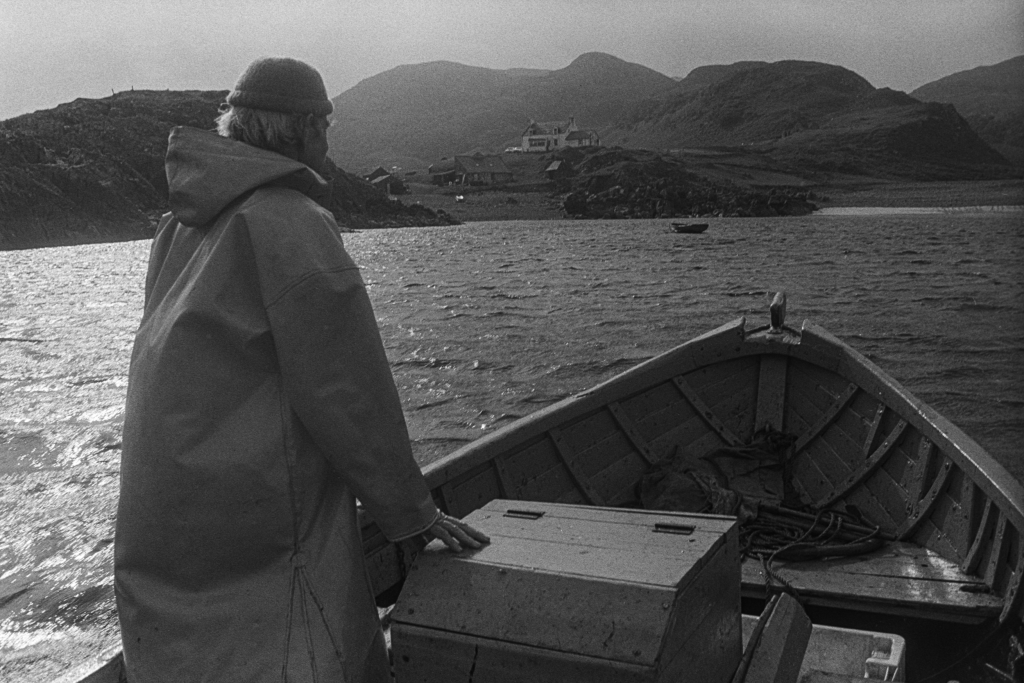
At this time, the packed salmon was transported via the Kilchoan – Tobermory ferry each day. Bobby had a reputation of not giving way to other vehicles she met on the single track roads as she made her way to catch the ferry. She made sure everyone else reversed to let her through.
Some beautiful photos and more information about this phase of the fishery can be found here
After the Macleods gave up the fishings, Mark and Nicky James took over at Fascadale in 1986 with their young family. They are remembered for producing smoked salmon, adding more value to the catch. Mark sadly disappeared while diving in 1991. Subsequently, Ardnamurchan Estate took the ownership once again and after some of the buildings were dismantled, the fishing station reverted to the peaceful bay with its grazing animals and holiday cottages seen today.
Salmon fishing continued at Kilchoan after the Macleods stopped. Alasdair Maclean from Mull took on the lease, followed by Paul Taylor, who had worked at Fascadale, and subsequently Dochie Cameron from Ockle. Catches were small.
Salmon fishing with fixed bag nets was finally banned in 2019.
Employees and work
Seasonal workers stayed in the bothy during the week in Fascadale, with locals returning home after the nets were removed on Saturdays until Monday morning. In the early days there were also bothies at Kilchoan and Ockle. In later years, the Macleods employed students who stayed in the Fascadale bothy for the whole summer.
The work was arduous and the weather not always kind despite the summer season. There was much hauling of heavy nets for cleaning and mending. Nets were hung out on posts to dry, a couple of these still remain at Kilchoan jetty. Stings from close encounters with jelly fish in the bag nets were frequent and painful. The work changed little over the years. Synthetic nets replaced heavier natural fibre versions and the ice machine replaced winter gathering but the essential bag net fishing, salmon weighing, packing and transporting changed little in over a hundred years.
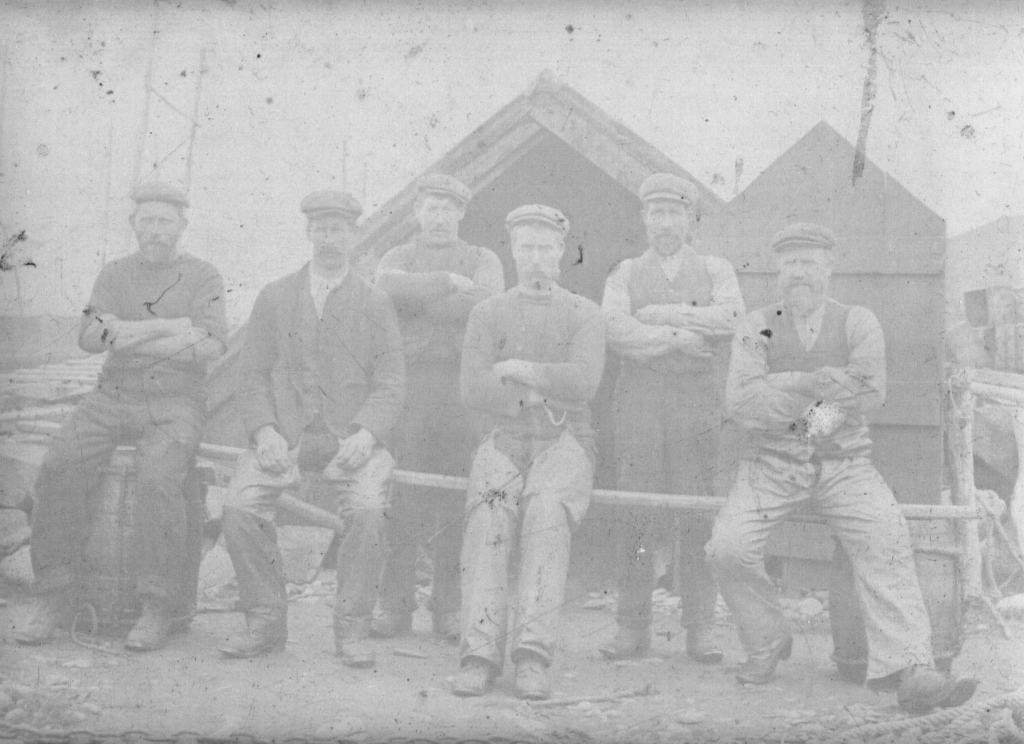
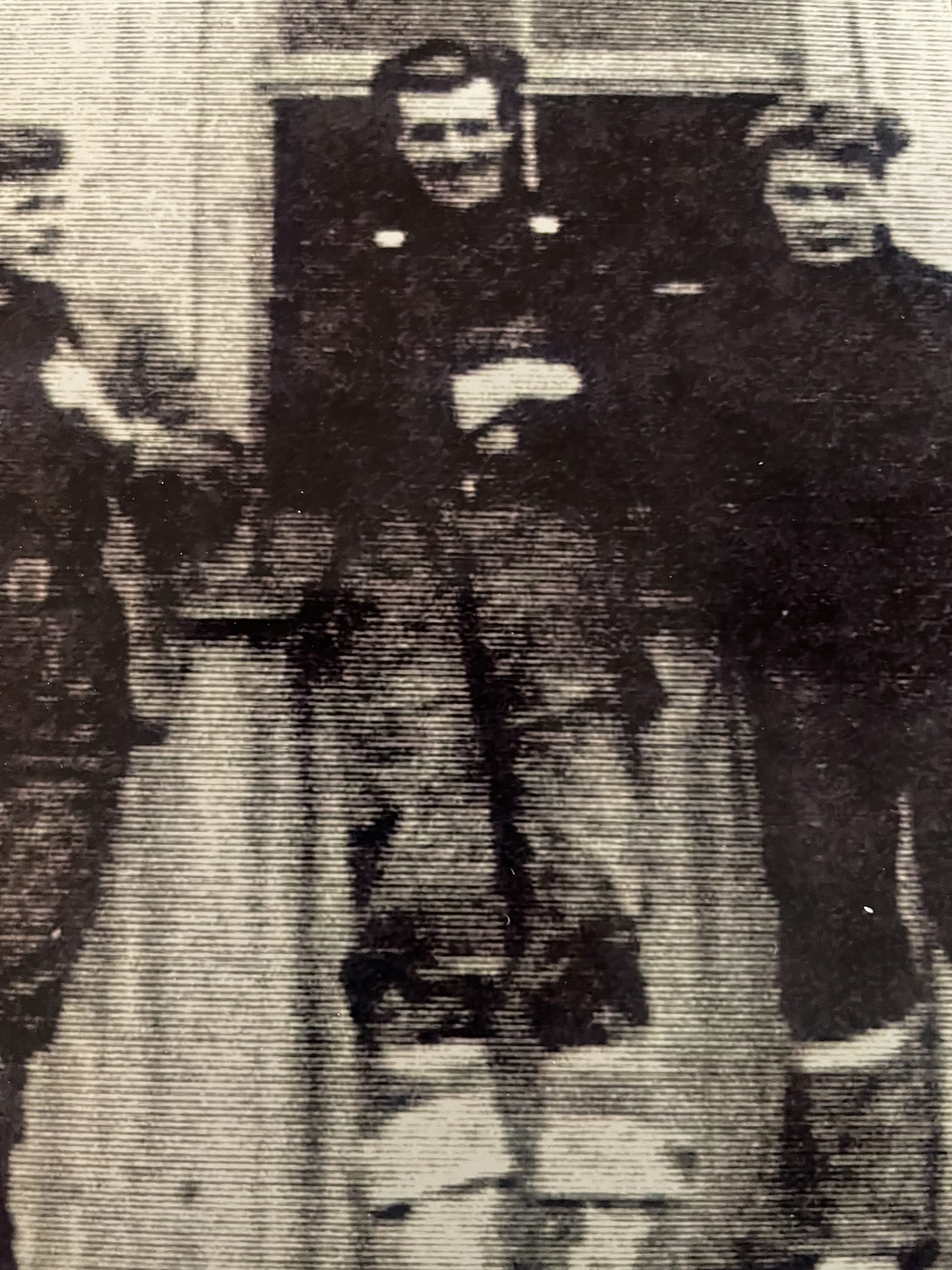
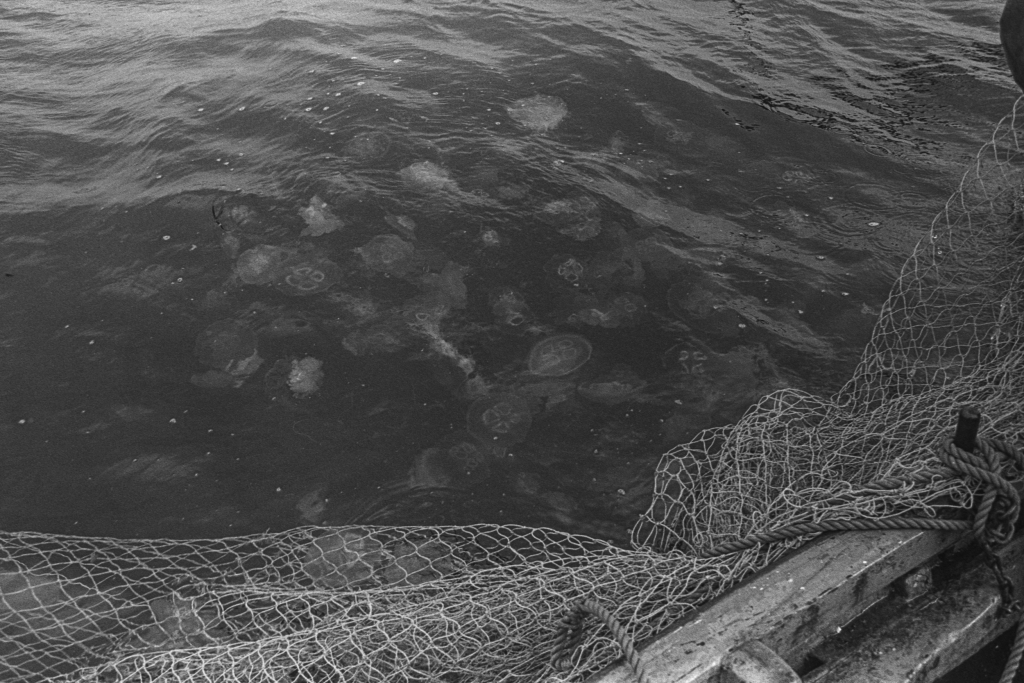
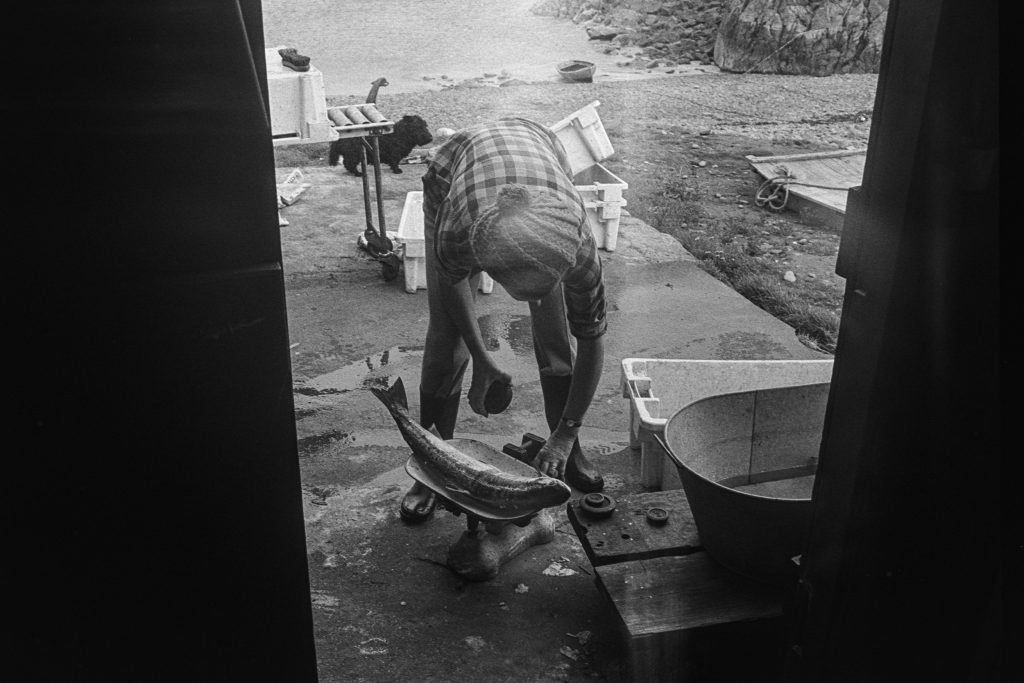
The story of the Coble OB209
The boat now sitting in the packing shed in Fascadale began her working life at Fascadale in 1912 with the Powries and after a few adventures elsewhere has returned home. The following timeline summarises her story.
2021 Late summer with a new coat of paint and in its final resting place in the packing shed at Fascadale. Thanks to Ardnamurchan Estate for allowing the boat to be housed here.
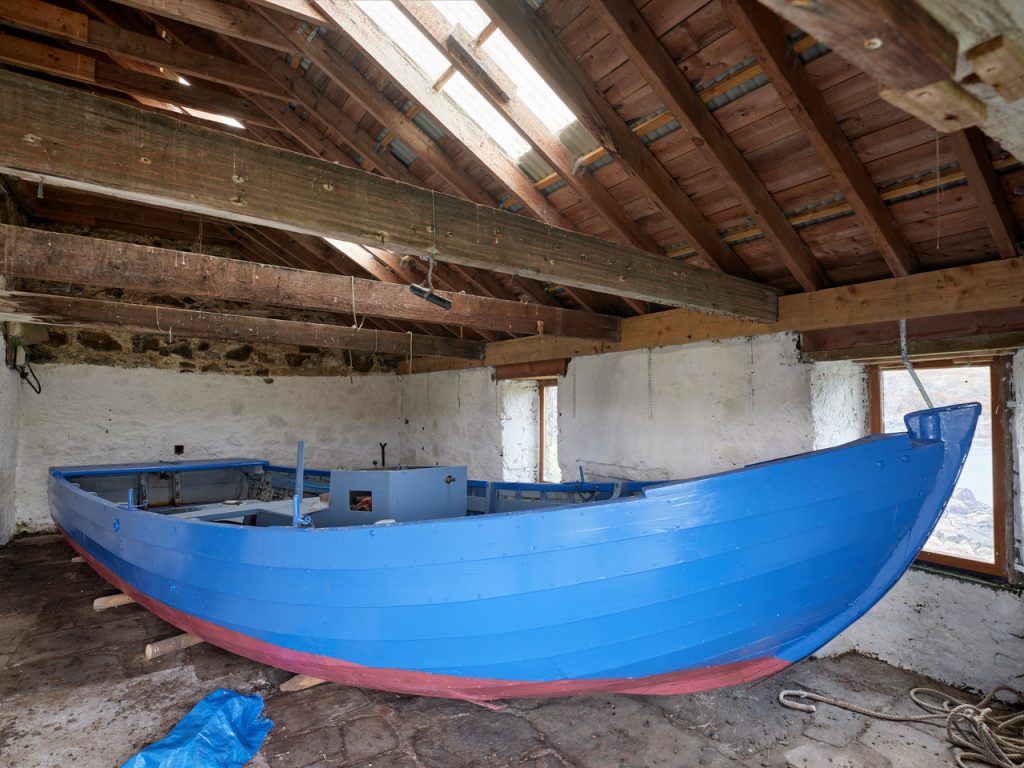
2021 Early summer. Returned from Hartlepool to Fascadale thanks to Chris Gane, Andy Barrett and Rosie MacLachlan for transportation.
2019 Paul Taylor negotiated for the return of OB209 to Ardnamuchan. Elaine Stokes of AHHA enthusiastically made it happen.

2017 taken to Hartlepool following closure of the museum for a boat maintenance course that didn’t materialise
2005 Given to the Eyemouth World of boats historic collection
2002 Moored in Granton
1998 Attended the Newhaven Boat Festival
1997 Restored at Cockenzie

1991 bought by Clive Simpson who continued to fish at Sorne Point. Renamed Pedro after Peter Maclean
@ 1985, via a couple of boat swaps and sales arrived back on Mull owned by Peter Maclean who fished the salmon nets at Sorne Point

1982 Bought by Paul Taylor who fished at Kilchoan for 2 seasons
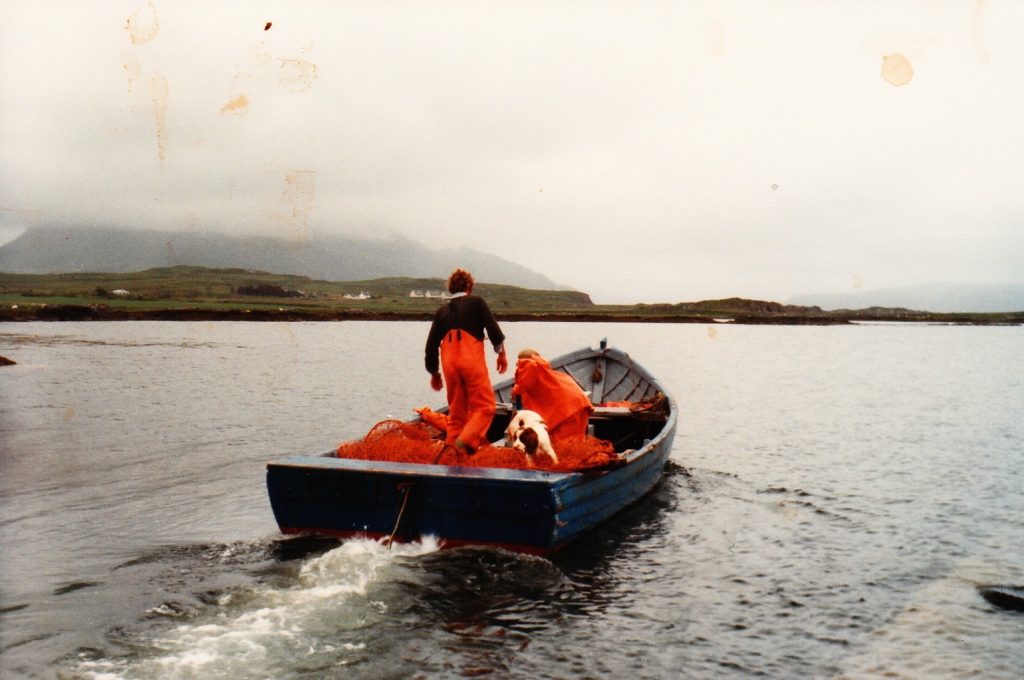
@1977 Bought by Alistair Maclean from Mull. Refurbished with new timbers and engine. Fished Kilchoan waters (now leased by Maclean)
1912 – @1977 Worked out of Fascadale for the Powries who might have called her Eun na mara (bird of the sea)
1912 Built (probably) at Aberdeen with a ‘poppet’ paraffin engine installed
References and further reading
[1] J Kirby (2015) The Lost Placenames of Ardnamurchan and Moidart, now out of print [2] Iain A. Robertson (2013) The Salmon Fishers. A history of the Scottish Coastal Salmon Fisheries [3] Hoffmann, R.C.(2015) Salmo salar in late medieval Scotland: competition and conservation for a riverine resource. Aquat Sci 77, 355–366See also
Environment and Forestry Directorate (2014) The land of Scotland and the common good: report (2014) ISBN 9781784124809
[4] Pickard C, Bonsall C. (2022) Reassessing Neolithic Diets in Western Scotland. Humans. 2022; 2(4):226-250. https://doi.org/10.3390/humans2040015 [5] The Statistical Accounts of Scotland 1791 – 1845, available online https://stataccscot.edina.ac.uk/static/statacc/dist/exhibition/nsaFurther reading:
Paul Taylor’s collection of beautiful photos and description of the fishery in the 1970s and 80s https://fascadalefishings.com
Michael Barrett’s (a Fascadale employee in the 1970s) entertaining book (2016) The Leaper. Adventures in a Commercial Salmon Fishing boat
Mike Smylie’s book (2021) Voices from the Shoreline
